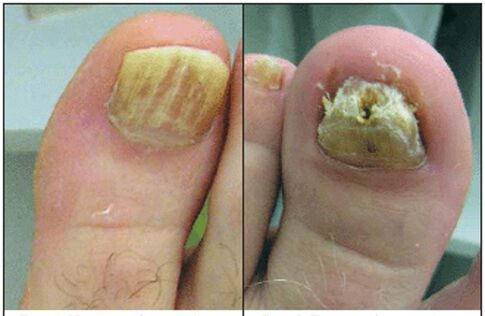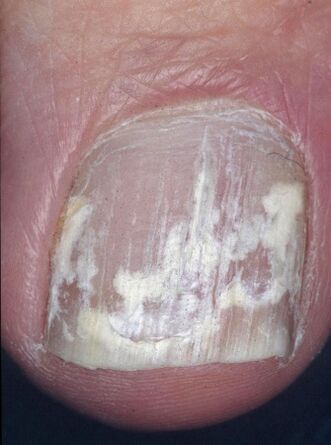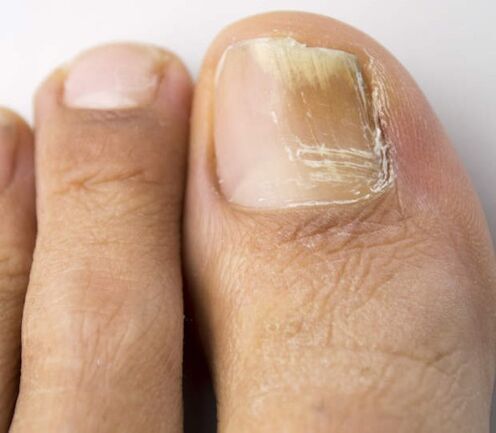To start treatment of onychomycosis on time, you need to know what the nail fungus looks like.Mushrooms that refer to the types of dermatophytes, candidates and hedicular -like can provoke the disease.The timely and correct determination of the pathogen enables you to heal the fungus quickly and effectively on your feet.
What is nail fungus?
The mushroom disease of nails has a scientific name - onychomycosis, which means "chronic infection" from ancient Greek.This disease influences the nail plate in which the force was broken for some reason.Mushrooms are increased quickly, they do not need any special development.The disease itself does not occur due to the high level of survival of fungi.
Causes of nail fungus
Factors on which the nail fungus manifests itself:
- Wet and warm surroundings.After a long day in shoes, the legs sweat a lot.It is necessary to dry shoes and completely give up synthetic socks.
- Age.The largest number of illnesses takes place between the ages of 18 and 55.Basically, men suffer.If nail fungus occurs extremely rarely in young people, then the percentage of at least 90%in men of older times.This is primarily due to the decreasing growth of nail plates.
- Medicines.Taking medication such as antibiotics and cytostatics can cause the disease.
- The immune system.After you have stepped on every dirty surface with unprotected legs, you can easily infect yourself.A person with weak immunity, doing this, is much easier.
- Profession.Nail fungus can occur due to the high temperature in the work space, in the seal or in the ionizing radiation.Minen employees, medical facilities, bathrooms and showers are most susceptible to the disease.
Three main paths were identified on which the mushroom can fall under the nail plate of the leg:
- Through the nail roller.The nail roller is a skin fold that surrounds the nail plate of 3 sides.
- Through the edge of the nail.In this case, the mushroom falls under the nail and not on it.In the future, this can develop into keratosis - an illness in which the nail separates from the nail bed.
- Through the dorsal part of the nail.This part is the most durable, which is why the fungus penetrates it much less frequently.
Types of nail fungus
What the nail fungus looks like depends on the type of fungus the disease provoked
Dermatophytes
This is the most common type of fungal diseases.The nail plate with dermatophytes is affected in 90% of the cases.
There are 3 varieties of this disease, each of which has a different area of the lesion:
| Trichophyte rubrum | Influence nails and feet |
| Epidermophytes | The fungus manifests itself on the 1st and 5th toes |
| Trichophytes | The fungus manifests itself on the 1st and 5th toes, can go to interdigital folds |
Shape
This type of illness is extremely rare.When the nail plate is infected, the color changes and becomes black, yellow, brown or blue.
Yeast -like mushrooms
These mushrooms can not only manifest themselves on nails, but are also the cause of the throttle in girls.The disease makes the nail thinner.The nail plate achieves yellow.If the disease is ignored, it is possible to separate the nail from the box.
Disease stages

What the nail fungus looks like depends on the stage of the disease.
In medicine, it is common to distinguish three main stages of its development:
- In the first phase it is quite difficult to identify the presence of the mushroom.Everything because there are no visible characters.
- The second stage.When the nails move into the second stage, the color of the plate gradually lose.The nail becomes brittle on the edges.You can already see small white spots or grooves that increase the size over time.
- The third stage is a neglected form of pathology when a person ignored the disease for a long time and did not treat it.At this point there is a great risk of losing the nail.It begins extensively and breaks more and more.
What does the nail fungus look like: symptoms and characters
The mushroom has serious symptoms.At the beginning of the disease, the shine on the nail gradually disappears.The surface of the plate will appear wavy, small white spots.
Over time, the nail becomes brittle, scaly.Despite its fragility, the thickness of the nail can increase.Perhaps an unbearable feeling of fingers to Jews.Sleeping in the legs gradually increases.Probably the appearance of grains and bubbles.
Another clear sign of the disease is an unpleasant smell.This is due to the fact that the gap between the fingernail and the bed is clogged with dirt and the products of the mushroom.
If the disease is started, the patient can increase the temperature and pain in the legs, which prevents him from moving normally.
Regional onychomycosis
Regional onychomycosis is the original stage of the disease.It is quite difficult to determine the disease in this stage.
What the nail fungus looks like depends on the development of pathology.A narrow gray lines are gradually appearing along the edges of the plate.The nail itself begins too blunt.Yellow spots of small sizes appear in the middle of the nail.The plate does not change the thickness, but becomes fragile.
The nail is not fully affected.Only his individual sections suffer.Therefore, the surface of the affected nail is checked.You can look at the gray substance under the nail, but the nail itself does not become thicker.
Normotorophical

Normotrophic onychomycosis takes place for the same reasons as the rest of the mushroom.Microorganisms get into the skin, according to which it penetrates deep into the nail plate from its surface due to small damage.
With normotrophic onychomycosis in the first days of the disease, the color of the nail does not change completely, but only in areas.On the sides and at the end the nail becomes white, yellow or gray.The nail plate loses its shine and fades.Over time, the color of the nail changes completely, but its thickness does not decrease.
Hypertrophic
Hypertrophic onychomycosis is seen as an advanced form of a normotrophic type of illness.The causes of the occurrence do not differ from the causes of other types of nail fungi.
The occurrence of hypertrophic onychomycosis contributes to contact with infected people who have unpleasant shoes or hygiene disorders.The cause can also be diseases: HIV, hyperhidrosis and diabetes.
The thickness of the nail increases significantly on the legs with hypertrophic onychomycosis.The thickening of the plate can lead to a disease such as hyperkeratosis (with an illness, the skin is keratized under the nail).
The color of the plate changes, which is why it looks yellow or gray.Nails become opaque, blunt.The appearance of onichogrifosis is possible - a mushroom in which the nail is deformed and takes over the shape of a bird claw.
With hypertrophic onychomycosis, the sides of the nail suffer the most.As a result, severe pain occurs in the fingers and prevent a person from moving normally.
White superficial shape

The white surface of onychomycosis is the rarest type of illness.This damages the thumbnail and the little finger.
The nail leg and the matrix do not suffer from the disease.White spots are gradually appearing on the surface of the nail.Over time, its size and area increase.The color of the stains changes from white to yellow.The nail begins to crumble.
If the disease is started, inflammation of the skin around the nail is possible.Together with him, severe redness and itching appear.
The thickness of the plate does not change and its surface becomes rough.Often the nails break, gloss disappears.
People who endanger the most to get sick:
- Bathroom;
- Saunas;
- Public books.
The combination of high humidity and heat is an ideal environment for the quick development of a fungal disease.Those who use common products from hygiene and shoes are very endangered.
The white surface of onychomycosis is easy to confuse with such diseases:
- Seborrhea.
- The first stage of eczema.
- Psoriasis.
Therefore, the dermatologist does not stop in a visual examination of the patient.Mandatory takes him biological material and sends him to the laboratory to determine the type of pathogen.
Onycholithic
Onicholytic onychomycosis is marked by the box by separating the nail plate.The nail loses its shine and becomes gray.In the damage area there is a diagram that is covered with hyperkeratosis (excessive thickening of the layer layer of the epidermis, it can be from 1 mm to several cm).
In the event of a disease, both thickening of the nail and a thinning are possible.
Candidiasis onychomycosis
This type of illness occurs due to a decrease in the protective properties of the skin coating and the weak immunity.Candida mushrooms that live in the intestine and in the urinary tract begin to multiply quickly and populate nail plates.The disease is most common in the female half of the population.Most of the time people suffer from waiters and dishwasher.
At the beginning of the disease, the mushroom influences the nail roller and the skin next to it.The skin flushes and begins to be inflamed.The swelling of the roles, the skin on it disappears practically.If the disease is not treated, it can develop into chronic and shabby skin in the area of nail and nail rollers.
The rejection of the treatment can lead to a deformation of the nail.It starts from the roller to the middle of the nail.It gets thinner and with a light press on the plate, the pus is possible.Wavy white stripes are clearly visible on the plate itself.
There is proximal candidal onychomycosis.The difference is that the nail roller does not suffer.The determination of the disease is supported by white dots of small sizes under the fingernail.
The third form of candidal onychomycosis is distal.The fungus affects the remote part of the nail and moves in the middle.The color of the plate changes and the nail becomes thicker.Hyperkeratosis occurs under the nail, which is why the nail rises.
Proximal deforming

The proximal -deforming onychomycosis begins to develop in the candidal lesion of the nail plate.The main feature of the disease is the nail bed.With this form of the disease it is deformed and becomes in the form of a wave.
Atrophic
Atrophic onychomycosis is marked with a brownish gray by changing the color of the nail plate.The nail is affected by the outer end and gradually moves to the skin roller.
There are also signs of such signs:
- Loss of a natural shine of the nail.
- The plate is atrophied.
- The nail bed is exposed.
- The nail will be thinner and atrophy in the future.
- There is a stratification of skin scales on the nail bed.
- The infection applies to neighboring tissue.
With atrophic onychomycosis, only the sprout of the nail does not remain touched.
Treatment methods
Before you start treating onychomycosis, you must contact a dermatologist to diagnose.A further treatment of the patient is only prescribed after laboratory tests and the determination of the size of the affected areas.
As a rule, local medication and medication are used in the treatment of onychomycosis to take orally.
In addition to taking medication, it is recommended for more effective treatment to treat personal objects and general objects in order to rule out the re -in -in function.
Maybe treatment with the following species:
- Physiotherapy.This procedure is prescribed to improve the blood flow to the limbs.Physiotherapy is used in combination with UHF and amplipular Carlation on the lumbosacral and cervix departments.Laser therapy and diathermia are also used.
- In the event of a neglected illness, the doctors decide to remove the nail plate when the nail is deformed and the peeling decides.This will further prevent the spread of the fungus and give medication more efficiently for a healthy surface.
Pharmacy products
The main methods for combating fungal diseases include antifungals.They damage the nail fungus more damage and therefore treat the affected areas effectively.Anti -Kikats are suitable for treating almost all types of illness, with the exception of the candidate (the treatment must be selected individually).
Dermatologists often prescribe the following antimictics:
- Lacquer that can protect the nail from further development of the disease.
- Solutions that destroy the mushroom from the nail rollers and from the plate itself.
- Ointments or gels that relieve itching and inflammation.
If the local treatment does not give the right effect to the fullest, the preparations for intake are mandatory.The main difficulty in the treatment of such means is a large number of contraindications and precautions.The effect of drugs gradually increases.
Traditional medicine
Folk medicine can be applied when treating fungal disease, but only in connection with other medication.
Tea mushroom

To use it, it is necessary to dampen your legs.After that, a small piece of the mushroom is applied to the sick nail, which is bent with a bandage.The compress lasts all night and is removed in the morning.Deletion the dead areas should be removed and then treat the surface with any antiseptic.The course of treatment takes several weeks.
Air
The Calamus cupboard can also become an assistant in the fight against the mushroom of the nail.Take such a decoction three times a day.During the reception, it is necessary to cut the tuned skin and growing nails.
- To prepare the product, it is required 2 teaspoons.Grind the rhizome of the plant and pour boiling water (usually 100 ml is enough).
- Then the rhizomes are not cooked in water for more than 1 min.
- When the product has cooled, it is ready for use.
Due to the fact that the decoction has a bitter taste, it can be washed off with water.
Vinegar
Acetic residents only have a good time in the early stages of the disease.In the future, they will only be used with the doctor's permission and together with other medication.
Acetic acid washing makes the epidermis soft, improves blood circulation and also changes the appearance of the feet.
Vinegar can be used in combination of the following components:
- Soda.It makes out the epidermis noticeably and improves the effect of the entire procedure.To prepare a solution for the procedure, 0.5 tablespoons must stir to 3 liters of water.Vinegar with 2 tablespoons.l.Soda.
- Essential oils.Such a component reduces the course of treatment several times.3 drops of oil are required for a vinegar bath.
- Glycerin.For 3 liters of water, 9 tablespoons.l.Vinegar and 3 tablespoons.l.Glycerin.When producing the solution, the water is added to the water glycerin for better dilution.Glycerin in vinegar baths helps to moisten the skin of the legs.
Baths can also be used as prevention.
There are a number of contraindications in which vinegar baths cannot be used:
- Oncology.
- Wounds, ulcers and scratches on the legs.
- Individual intolerance.
- Thrombophlebitis.
- Pregnancy.
- Violations of the cardiovascular system.
- Age up to 10 years.
Before the procedure, you have to carry out 3 steps:
- Make a sensitivity test.A small area near the elbow is moistened with a prepared solution.After 15 minutes.There should be no allergic reactions (itching, combustion, redness).
- Before the procedure, the legs must be steamed and the affected substances removed.
- After the procedure, you have to rinse your feet and dry well.You cannot load your legs for 2 hours.
- The duration of the procedure is 10-20 minutes.
In general, treatment with vinegar baths takes 2-3 weeks.
Tea
The use of tea tree oil contributes to the effective restoration of the affected nail.During the procedure, oil should be applied in the calculation of 1 drop per 1 nail under the nail.The procedure is carried out three times a day.The treated areas of the nail should be glued with a patch so that the effect of the treatment is higher.
Iodine processing

In the fight against nail fungus, iodine is widespread.It is best to use a 5% solution for the procedure.Everything that is needed for the treatment is to apply a solution from iodine 2 times a day to the affected nail area.
When applying iodine, a feeling of burning is possible.If the burning feeling is weak and does not cause any symptoms, everything is fine.If the pain is serious, iodine processing should be stopped immediately.Treatment with a iodine solution is 2-3 months.
The advanced stage of the disease can lead to more serious consequences.Regardless of the independent treatment that the patient does, the first signs are necessary to consult a specialist.Incidentally, what the nail fungus looks like can prescribe full treatment.Onychomycosis on the legs is treated quite quickly and effectively with the correct approach.


















